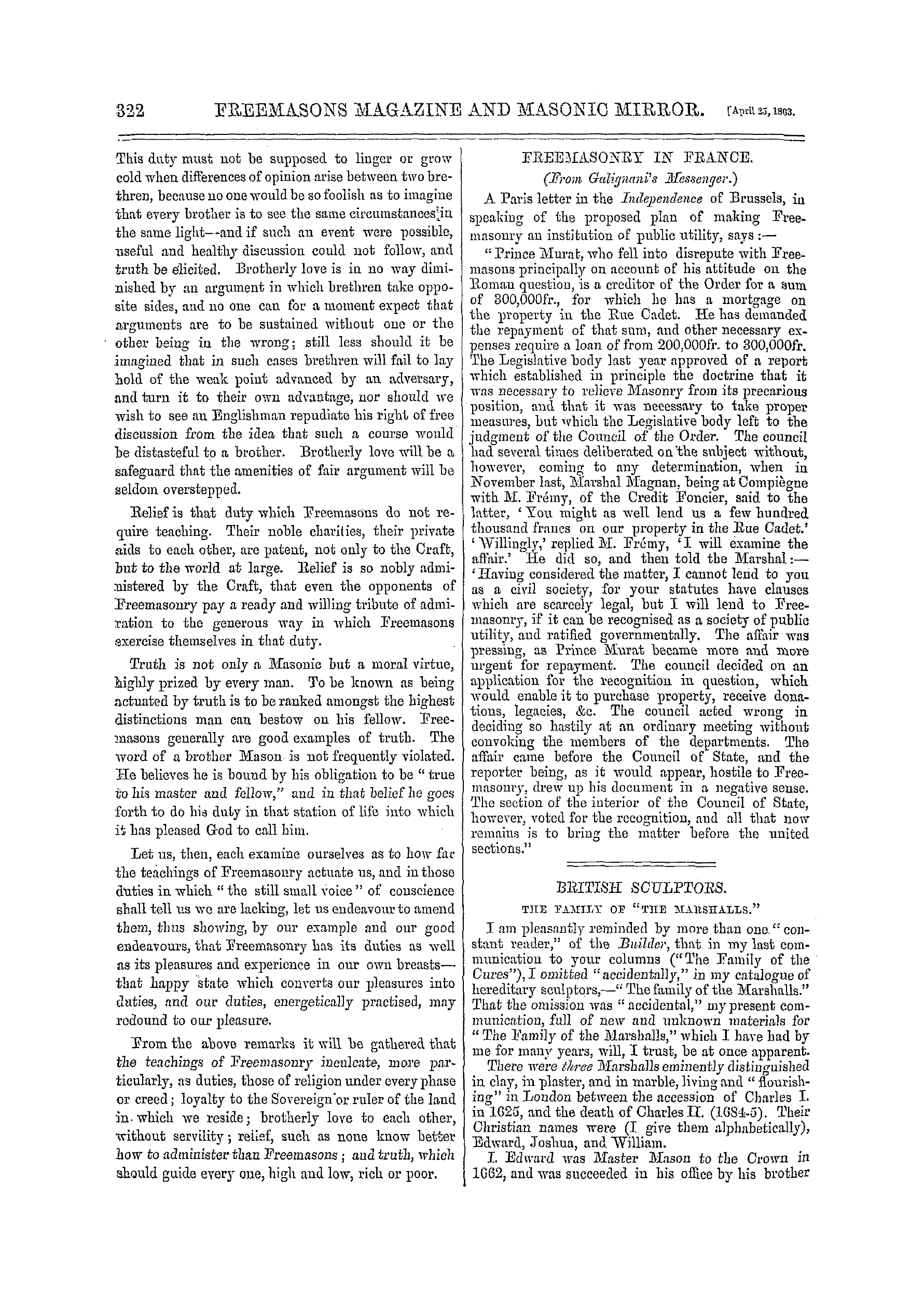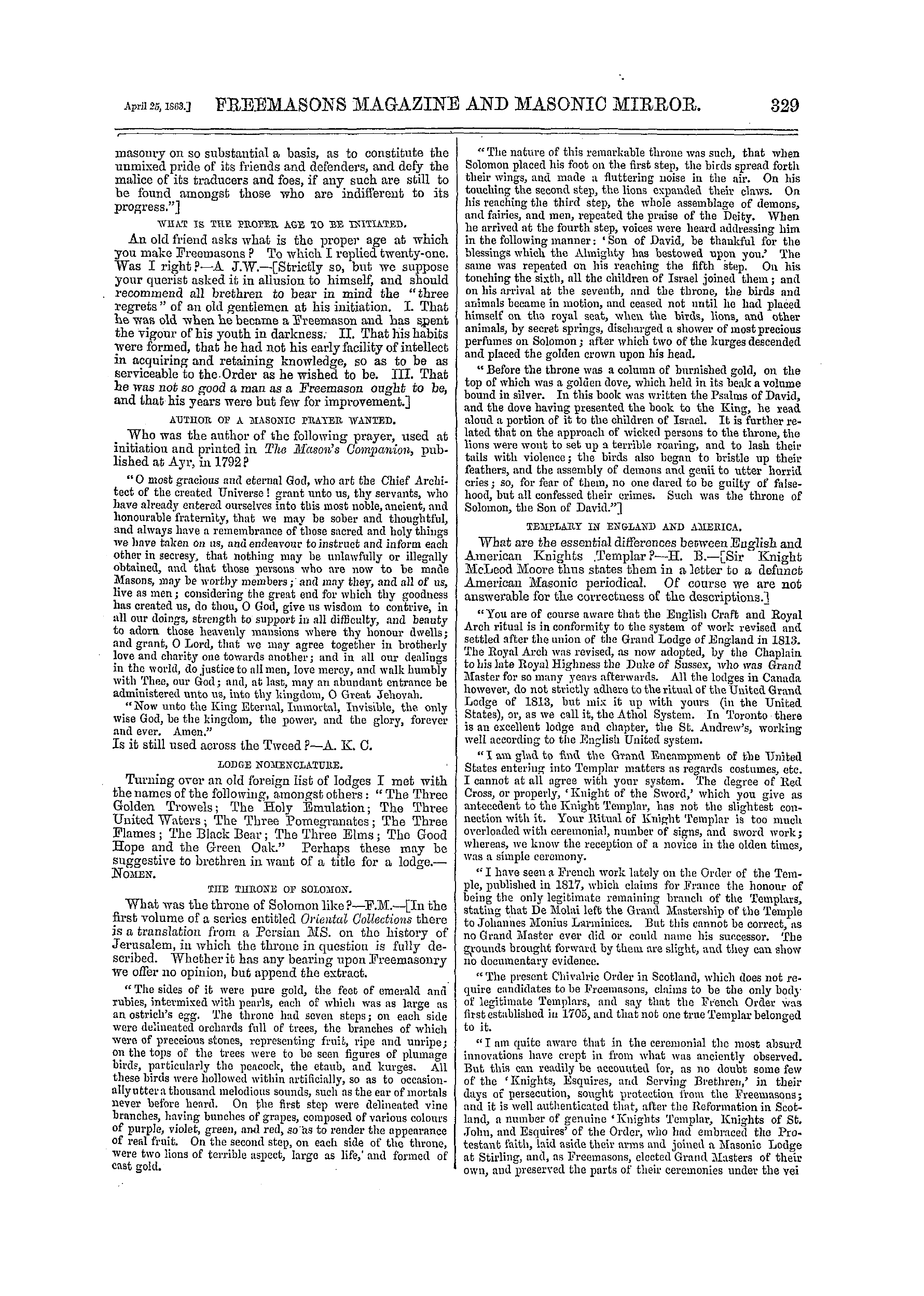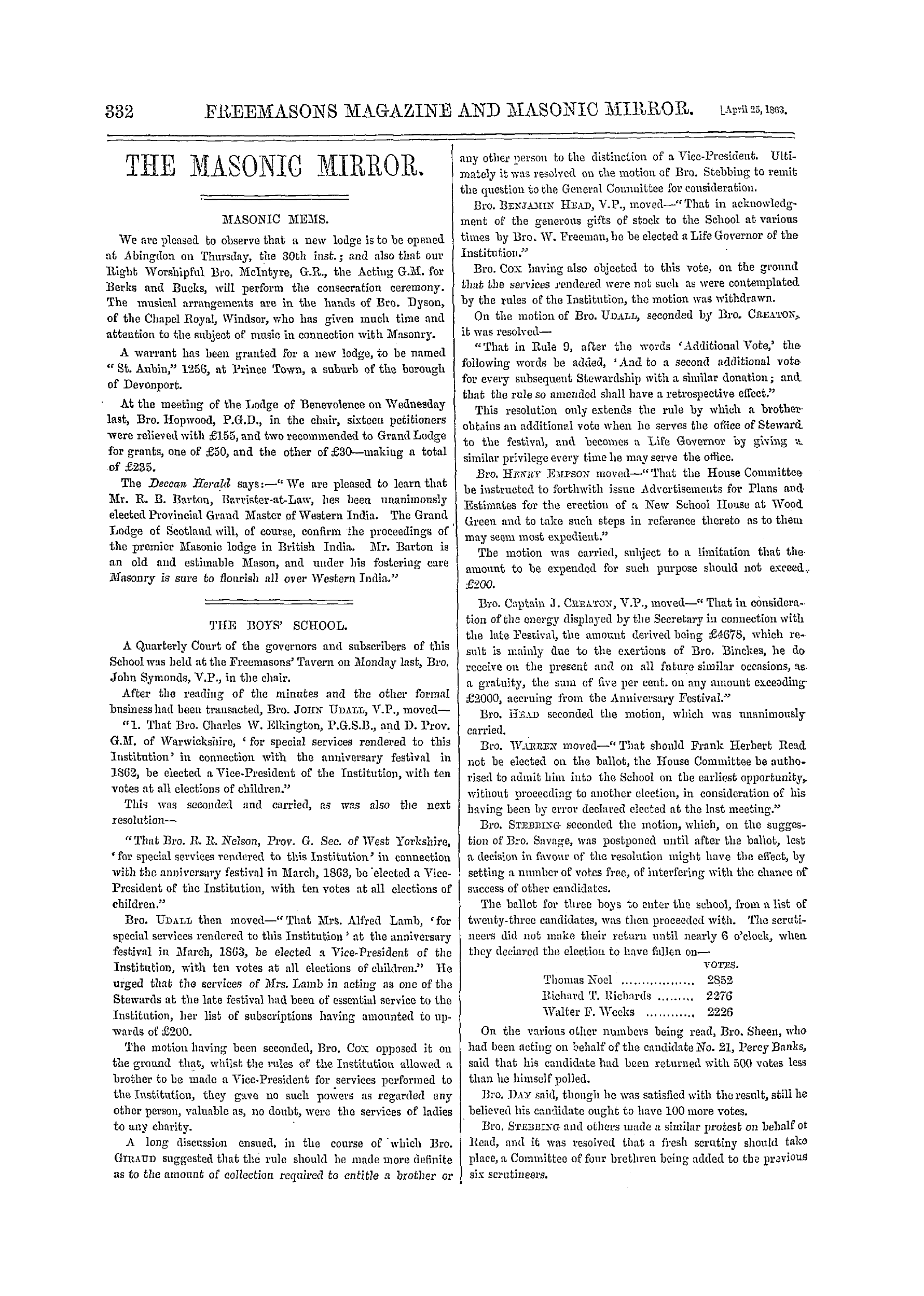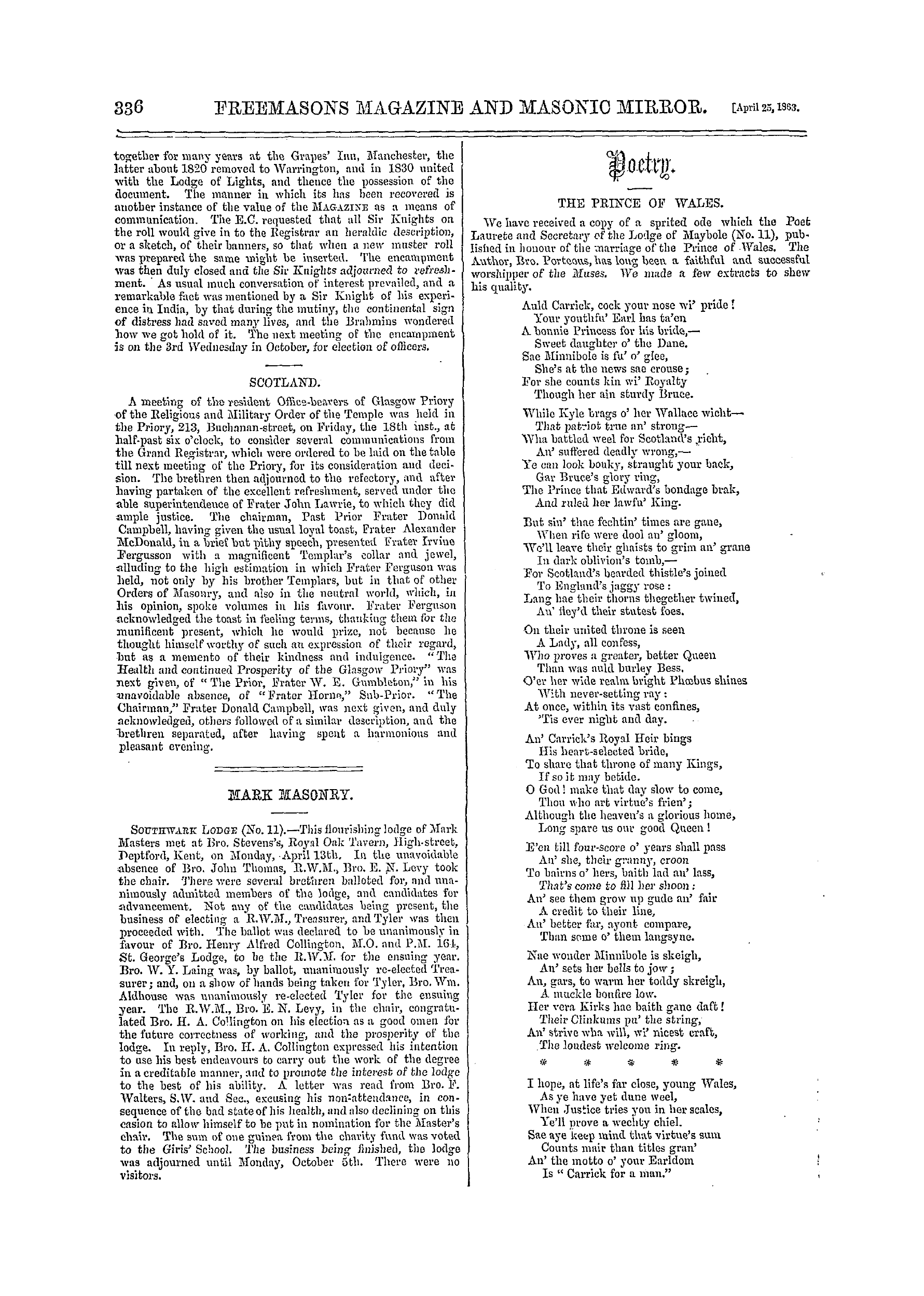-
Articles/Ads
Article KNIGHTHOOD. ← Page 3 of 3 Article THE CORONATION CHAIR, WESTMINSTER ABBEY. Page 1 of 3 →
Note: This text has been automatically extracted via Optical Character Recognition (OCR) software.
Knighthood.
The Order of the Crescent , created by Bene , Duke of Anjou , A . D . 1462 , when he conquered Sicily . Motto : Zos . The Order of the Jar , made by Don Garcia , king of Navarre , in remembrance of a vision he saw in a cave , when out hunting , of a pitcher of lillies on an altar before an image of the Virgin .
The Order of the Golden Shield , founded by Louis II . Motto : Allans . The most ancient Order of the Genette , or Horse-bit , founded by Charles Martel after the defeat of the Saracens in the great battle of Tours , A . D . 783 . The Knights de l'Epi , or ear of corn , or of the Ermine , established by Francis I . " "
The Knights de 1 'Etoile , or of the Star . Motto : Monstrant Regibus astra viam , the stars show a way to kings . Spain has instituted several orders of knighthood : — The sovereign of 'S pain is chief of the Order of the Golden Fleece appointed by Philip , Duke of Burgundy , upon his marriage with Isabel of Portugal . Motto : Ante ¦ farit quam , jlammo micet
Alonzo VIII , A . D . 1118 , founded the Order of San Salvador in Arragon . The Knights of St . Maria de Mercede are a Spanish order , as are those of Montesia . The Knights of the Pear-tree , created A . D . 1172 , were subsequentlknown as Knihts of the Alcantra in Leon .
y g The Portuguese own the startling Order of the Knights of Jesus Christ . Poland can boast two orders , —that of the White Eagle , founded by Ladislaus V , A . D . 1325 ; and that of the Militia Christians . Venice owns two orders , —that bf St . Mark and that of La Calza , or the Stocking .
Sweden possesses an order entitled the Knights of the Sword and Baudrick . The Duke of Savoy was confirmed Grand Master of the Order of St . Maurice and Lazaro by the Pope ,
A . D . 1119 . Cosmo , Duke of Florence , instituted the Order of St . Stephen , A . D . 1591 . It is an instance of the medissval alliance between priesthood and knighthood to find Pope Alexander III ., instituting an order of knighthood in which the rule of St . Augustine was to be observed . It was called the
Order of St . Jago or St . James . As an instance of the services rendered by knights , we would point to the Teutonic Knights , upon whom the Emperor ] Ferdinand IL , bestowed Prussia , A . D . 1226 , on condition that they would subdue the infidels , which they succeeded in doing ; and although this bravery may seem a species of kniht-errantry when associated with times
g so remote , we have an order instituted in our own day , by our most Gracious Queen , as a recognition of scarcely less chivalrous service—the Order of the Star of India . This is a curious chapter in the history of this age of commerce , iron , and steam power , akin to the largesse so bountifully bestowed upon Lancashire at need . St . George may be proud of England still . —Builder .
The Coronation Chair, Westminster Abbey.
THE CORONATION CHAIR , WESTMINSTER ABBEY .
Allusion was recently made to the coronation stone sot within the ancient chair which is now preserved near Edward the Confessor ' s shrine in Westminster Abbey . The traditionary history of this stone is remarkable , but it is only traditionary . It has been , known as the " prophetic" or "fatal" stone , which tradition asserts is the same whereone Jacob rested his head when he saw the
vision of the ladder reaching to Heaven , with the angels of God ascending and descending the plain of Luz . From various sources we have evidence of the great antiquity ofthe practice of crowning kings on an elevated stoueor
by a pillar , and the custom may still be said to form part of the coronation ceremonies of our own country . Besides the stone in Westminster Abbey , there still remains the stone at Kingston-upon-Thames , on which several of the ancient kings of England were crowned . The Scriptures show that the Jewish patriarchs erected stone pillars on different occasions , but chiefly from
religious motives ; and that these monuments were , at subsequent periods , dedicated to the most important national purposes , particularly to the creation of kings . The stone which Jacob had made his pillow he afterwards set up as a pillar , and poured oil upon the top of it , saying , " And this stone , which I have set up as a pillar , shall be God ' s house . " He also changed the name of the name of the
place from Luz to that of Beth-el . He likewise set up a stone for a pillar at Galeed Mizpah , on the spot where he entered into a lasting covenant with Laban , and at that spot Jephtha was solemnly vested with the government of Gilead . At the stone which Joshua had set up , Abimelech was made king . Adonijah usurped his brother ' s crown , and held a feast at the stone
of . Zokeleth , and Jehoash was crowned and anointed king , standing by a pillar , as the manner was . Josiah also stood by a pillar , with all his people , in the Temple at Jerusalem , when be made a solemn covenant to keep the ordinances of the Lord . * It is probable that the custom of inaugurating kings by placing them either upon or near an elevated stone
spread extensively through the East , as it certainly did from thence to the Celtic and Scandinavian nations . The Persians had their " artioze" or fatal stone , the use of which with them was to point out the most deserving candidate for the throne . Amongst the Norwegians , Swedes , and Danes , the practice was to form a circle of stones , commonly about twelve in number , in the middle of which was set up one larger than the others . This
was the royal seat , the nobles occupying those surrounding it , the people standing without . Here the leading men of the kingdom gave their suffrages , and placed the elected king on his throne . Monuments of this kind remain in Denmark , and traces of them may be found in Shetland , the Hebrides , Isle of Man , and elsewhere . A rude enthronement , somewhat similar to that of the
Northmen , is to be found among the Celtic tribes ; and the kings of both Scotland and Ireland were placed upon a stone at the time of their election . The consecration of peculiar stones and rocks formed a branch of Druidical superstition , and the votaries of Druidism were taught to believe that there was great virtue in stones thus hallowed . " The stone of power " was a flat stone , usually
black , which the Druidical priests were said to " consult ;" probably they slept upon it , like Jacob , and had what they regarded as celestial and oracular visions for their guidance . The Arch-Druids , too , sat in a stone chair , to which they attributed wonderful virtues , and which appears to have partaken of the nature of a bishop ' s throne . They spoke mysticallof " awakening" the chair of the Taliesin
y at Caer Sidi , and declared that he who sat in it would suffer neither disease nor decay , but become one of the " twice-born " and " deathless brotherhood . " It is conjectured that the stone below the coronation chair may have been Druidical . There were formerly some rhymes current in Ireland which imply that the Scotch , although of legitimate descent , would fail to preserve regal power
unless in possession of tho Fatal Stone . From Fordun's account of the Coronation Stone we gather some particulars respecting its legendary history . There was a certain King of Spain , of the Scottish race , called Milo , who had many sons : one , however , named Breh , he loved beyond all the others , although he was neither the eldest nor the heir . He therefore sent him to Ireland with an army , and gave him a marble chair ,
Note: This text has been automatically extracted via Optical Character Recognition (OCR) software.
Knighthood.
The Order of the Crescent , created by Bene , Duke of Anjou , A . D . 1462 , when he conquered Sicily . Motto : Zos . The Order of the Jar , made by Don Garcia , king of Navarre , in remembrance of a vision he saw in a cave , when out hunting , of a pitcher of lillies on an altar before an image of the Virgin .
The Order of the Golden Shield , founded by Louis II . Motto : Allans . The most ancient Order of the Genette , or Horse-bit , founded by Charles Martel after the defeat of the Saracens in the great battle of Tours , A . D . 783 . The Knights de l'Epi , or ear of corn , or of the Ermine , established by Francis I . " "
The Knights de 1 'Etoile , or of the Star . Motto : Monstrant Regibus astra viam , the stars show a way to kings . Spain has instituted several orders of knighthood : — The sovereign of 'S pain is chief of the Order of the Golden Fleece appointed by Philip , Duke of Burgundy , upon his marriage with Isabel of Portugal . Motto : Ante ¦ farit quam , jlammo micet
Alonzo VIII , A . D . 1118 , founded the Order of San Salvador in Arragon . The Knights of St . Maria de Mercede are a Spanish order , as are those of Montesia . The Knights of the Pear-tree , created A . D . 1172 , were subsequentlknown as Knihts of the Alcantra in Leon .
y g The Portuguese own the startling Order of the Knights of Jesus Christ . Poland can boast two orders , —that of the White Eagle , founded by Ladislaus V , A . D . 1325 ; and that of the Militia Christians . Venice owns two orders , —that bf St . Mark and that of La Calza , or the Stocking .
Sweden possesses an order entitled the Knights of the Sword and Baudrick . The Duke of Savoy was confirmed Grand Master of the Order of St . Maurice and Lazaro by the Pope ,
A . D . 1119 . Cosmo , Duke of Florence , instituted the Order of St . Stephen , A . D . 1591 . It is an instance of the medissval alliance between priesthood and knighthood to find Pope Alexander III ., instituting an order of knighthood in which the rule of St . Augustine was to be observed . It was called the
Order of St . Jago or St . James . As an instance of the services rendered by knights , we would point to the Teutonic Knights , upon whom the Emperor ] Ferdinand IL , bestowed Prussia , A . D . 1226 , on condition that they would subdue the infidels , which they succeeded in doing ; and although this bravery may seem a species of kniht-errantry when associated with times
g so remote , we have an order instituted in our own day , by our most Gracious Queen , as a recognition of scarcely less chivalrous service—the Order of the Star of India . This is a curious chapter in the history of this age of commerce , iron , and steam power , akin to the largesse so bountifully bestowed upon Lancashire at need . St . George may be proud of England still . —Builder .
The Coronation Chair, Westminster Abbey.
THE CORONATION CHAIR , WESTMINSTER ABBEY .
Allusion was recently made to the coronation stone sot within the ancient chair which is now preserved near Edward the Confessor ' s shrine in Westminster Abbey . The traditionary history of this stone is remarkable , but it is only traditionary . It has been , known as the " prophetic" or "fatal" stone , which tradition asserts is the same whereone Jacob rested his head when he saw the
vision of the ladder reaching to Heaven , with the angels of God ascending and descending the plain of Luz . From various sources we have evidence of the great antiquity ofthe practice of crowning kings on an elevated stoueor
by a pillar , and the custom may still be said to form part of the coronation ceremonies of our own country . Besides the stone in Westminster Abbey , there still remains the stone at Kingston-upon-Thames , on which several of the ancient kings of England were crowned . The Scriptures show that the Jewish patriarchs erected stone pillars on different occasions , but chiefly from
religious motives ; and that these monuments were , at subsequent periods , dedicated to the most important national purposes , particularly to the creation of kings . The stone which Jacob had made his pillow he afterwards set up as a pillar , and poured oil upon the top of it , saying , " And this stone , which I have set up as a pillar , shall be God ' s house . " He also changed the name of the name of the
place from Luz to that of Beth-el . He likewise set up a stone for a pillar at Galeed Mizpah , on the spot where he entered into a lasting covenant with Laban , and at that spot Jephtha was solemnly vested with the government of Gilead . At the stone which Joshua had set up , Abimelech was made king . Adonijah usurped his brother ' s crown , and held a feast at the stone
of . Zokeleth , and Jehoash was crowned and anointed king , standing by a pillar , as the manner was . Josiah also stood by a pillar , with all his people , in the Temple at Jerusalem , when be made a solemn covenant to keep the ordinances of the Lord . * It is probable that the custom of inaugurating kings by placing them either upon or near an elevated stone
spread extensively through the East , as it certainly did from thence to the Celtic and Scandinavian nations . The Persians had their " artioze" or fatal stone , the use of which with them was to point out the most deserving candidate for the throne . Amongst the Norwegians , Swedes , and Danes , the practice was to form a circle of stones , commonly about twelve in number , in the middle of which was set up one larger than the others . This
was the royal seat , the nobles occupying those surrounding it , the people standing without . Here the leading men of the kingdom gave their suffrages , and placed the elected king on his throne . Monuments of this kind remain in Denmark , and traces of them may be found in Shetland , the Hebrides , Isle of Man , and elsewhere . A rude enthronement , somewhat similar to that of the
Northmen , is to be found among the Celtic tribes ; and the kings of both Scotland and Ireland were placed upon a stone at the time of their election . The consecration of peculiar stones and rocks formed a branch of Druidical superstition , and the votaries of Druidism were taught to believe that there was great virtue in stones thus hallowed . " The stone of power " was a flat stone , usually
black , which the Druidical priests were said to " consult ;" probably they slept upon it , like Jacob , and had what they regarded as celestial and oracular visions for their guidance . The Arch-Druids , too , sat in a stone chair , to which they attributed wonderful virtues , and which appears to have partaken of the nature of a bishop ' s throne . They spoke mysticallof " awakening" the chair of the Taliesin
y at Caer Sidi , and declared that he who sat in it would suffer neither disease nor decay , but become one of the " twice-born " and " deathless brotherhood . " It is conjectured that the stone below the coronation chair may have been Druidical . There were formerly some rhymes current in Ireland which imply that the Scotch , although of legitimate descent , would fail to preserve regal power
unless in possession of tho Fatal Stone . From Fordun's account of the Coronation Stone we gather some particulars respecting its legendary history . There was a certain King of Spain , of the Scottish race , called Milo , who had many sons : one , however , named Breh , he loved beyond all the others , although he was neither the eldest nor the heir . He therefore sent him to Ireland with an army , and gave him a marble chair ,



















